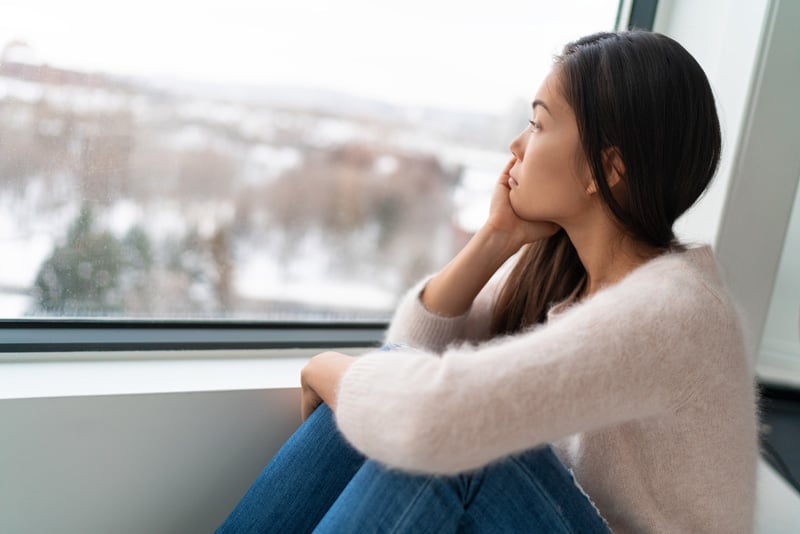
Common symptoms:
- Desire to oversleep
- Feeling of fatigue and inability to carry out a normal routine
- A craving for carbohydrates – overeating
- Loss of self-esteem
- Difficulty concentrating and processing information
- Tension and inability to tolerate stress
- Decreased interest in sex and physical contact
- Feelings of sadness or hopelessness
- Loss of energy
- Irritability and increased sensitivity
- Difficulty concentrating
- Thoughts of suicide
- Social withdrawal
If you are a woman, you are four times more likely to experience SAD than men. Those who live far north or south of the equator experience SAD more frequently. Those with a history of depression or bipolar disorder are more likely to experience this seasonal form of depression.
What Causes SAD?
The diminished level of sunlight appears to be a primary factor that affects serotonin, the neurotransmitter that impacts mood in very direct ways.
Additionally, melatonin, the sleep-inducing hormone that is produced increasingly in the darkness, is also linked to SAD. With shorter days, more melatonin may be produced affecting your circadian rhythm, and that sets off a series of symptoms commonly seen in SAD.
Coping Tips
Sunlight is crucial to human health, and when we don’t get enough exposure to it our moods and physical health will suffer. More specifically, your serotonin levels (the hormone associated with elevating your mood) rise when you’re exposed to bright light. You may have experienced this “high” feeling after spending some time on a sunny beach, for example.
Similarly, the sleep hormone melatonin also rises and falls (inversely) with light and darkness. When it’s dark, your melatonin levels increase, which is why you may feel naturally tired when it begins to get dark outside (even when, in the heart of winter, this may be at only 4:00 p.m.).
It is because sunlight affects the melatonin-serotonin system that it works so well to alleviate the symptoms of the winter blues and elevates mood. In fact, some studies have even found that light therapy or phototherapy, which is the practice of using full-spectrum light therapeutically, works to relieve the symptoms of the winter blues and SAD often better than some antidepressant medications.
Light therapy requires that you sit close to a special “light box” for 20-30 minutes a day. The light is best rated at 10,000 lux (“lux” is a measure of light intensity). By comparison, that is approximately 100 times brighter than usual indoor lighting. A bright sunny day is about 50,000 lux or more. There is no assurance that light therapy will be the answer, as it doesn’t work for everyone.
Light boxes, prescribed through your physician, made by a variety of manufacturers, are often recommended for serious cases of SAD. These light boxes are about the size of two computer monitors side-by-side and cost a few hundred dollars. The light box sits on your desk or table, and as soon as you get up you sit under it. The boxes screen out ultraviolet rays, so you won’t get skin cancer, but you also won’t get a tan. Experts think the bright sun-like exposure resets the body’s internal clock.
Some find that antidepressant medications and cognitive behavioral psychotherapy may also be of benefit. There are a number of studies that show that the use of cod liver oil or fish oil that are rich in essential omega-3, are associated with decreased depression. Both oils are linked to decreasing depression. Some SAD sufferers have found that adding Vitamin D to their diets also result in some mood lift at this time of the year, though changes may only be minimal if at all.
Exercise: The Gold Standard
The “gold standard” to increase winter wellbeing, reduce fatigue and elevate mood, is exercise. Research has demonstrated 30 to 60 minutes of physical activity in conjunction with just 20 extra minutes of sunlight exposure helps people avoid or manage SAD quite well. There are exercises that have been found to be better suited to minimizing SAD. These include working out on your Total Gym in the warmth of your home, low-impact aerobic activities, particularly walking. If you enjoy yoga, tai chi, swimming, running, and resistance training during the warmer months, doing so during the winter season is a wonderful way to defeat SAD. One review of more than 40 studies found that aerobic exercise like walking and running improve symptoms of depression considerably, although resistance training has been found to be even more effective at boosting mood. The research suggests that combination of the two works best to help reduce SAD. Remember the social aspect of exercise can also help combat symptoms of SAD.
The post Seasonal Effective Disorder appeared first on Total Gym Pulse.
